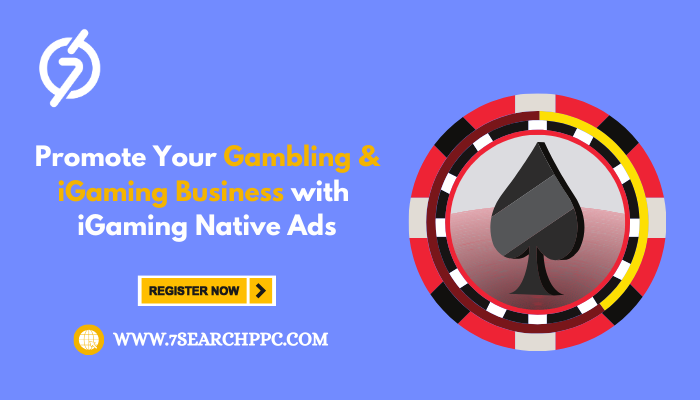In the highly competitive realm of iGaming, standing out is more crucial than ever. As traditional advertising methods begin to lose their charm, more brands are turning to innovative strategies such as iGaming native ads. This article delves into the transformative benefits of native advertising in the iGaming industry and how it can revolutionize your marketing efforts. We will explore key concepts, best practices, and answer frequently asked questions, while also discussing effective iGaming advertising strategies and crafting a compelling iGaming ad campaign.

<< Start Advertising & Grow Today! >>
Understanding iGaming Native Ads
What Are iGaming Native Ads?
iGaming native ads are a form of paid media designed to blend seamlessly with the content of the host platform. Unlike traditional display ads, these ads mirror the look, feel, and function of the surrounding content, making them less intrusive and more engaging for users. The ultimate goal of native advertising is to provide value to the user while subtly promoting the brand’s message.
Why They Matter in the iGaming Industry
The iGaming sector is characterized by its dynamic audience and rapidly evolving digital landscape. Consumers expect a high level of engagement and authenticity, and conventional banners or pop-ups might not deliver that experience. With iGaming native ads, brands have the opportunity to integrate their messages in a way that feels organic to the user experience. This seamless integration results in higher engagement, improved brand perception, and increased conversion rates.
The Benefits of iGaming Native Ads for Business
Enhanced User Engagement
One of the standout advantages of iGaming native ads is their ability to capture and maintain user attention. When content is presented in a familiar format, users are more likely to interact with the ad. This leads to a boost in metrics such as click-through rates (CTR) and time spent on the advertisement, ultimately driving higher engagement levels.
Increased Trust: When users see ads that match the overall theme of the content they are browsing, it builds a sense of trust and credibility.
Higher Relevance: The context-driven nature of native ads allows marketers to deliver messages that resonate with the audience’s current interests or needs.
Seamless Integration Across Platforms
iGaming native ads are inherently designed to adapt to the visual and functional characteristics of various platforms, whether it’s a website, mobile app, or social media channel. This versatility ensures that your message reaches your audience wherever they are, without compromising on user experience.
Multi-Platform Consistency: A well-crafted native ad maintains its appeal whether viewed on a desktop or a smartphone.
Non-Disruptive Format: By blending in with the host platform, these ads avoid the annoyance typically associated with traditional advertising formats.
Improved Conversion Rates
When ads align with the natural user experience, they tend to yield higher conversion rates. Native ads not only generate interest but also guide users seamlessly down the marketing funnel. For iGaming companies, this can translate to more sign-ups, deposits, and active players.
Personalized Messaging: Effective native ads can be tailored to specific segments of your audience, improving the relevance and impact of your message.
Call-to-Action (CTA) Integration: Subtle yet compelling CTAs within native ads can subtly guide users to take the desired action without feeling pressured.
Cost-Effectiveness Over Time
While initial costs for creating high-quality native advertising content may be higher than standard display ads, the long-term benefits often outweigh these expenses. Improved engagement and conversion rates result in a better return on investment (ROI) over time.
Sustainable Marketing Investment: Native ads, by their nature, contribute to sustained audience engagement, reducing the need for continuous ad spend.
Enhanced Brand Value: The seamless integration of your content can boost brand perception, turning one-time users into loyal customers.
Best Practices for Creating Effective iGaming Native Ads
Research and Understand Your Audience
Before launching any native ad campaign, a deep understanding of your target audience is essential. This involves gathering insights into user behavior, preferences, and interests.
Audience Segmentation: Break down your audience into distinct groups to tailor your messaging.
Analytics and Data: Utilize analytics to track how users interact with content and optimize the ad in real time.
Craft Compelling Content
Content is king, even in native advertising. The success of an iGaming native ad lies in its ability to tell a story that resonates with the audience.
Engaging Headlines: Use headlines that spark curiosity and invite the user to read more.
Visual Appeal: Incorporate high-quality graphics or videos that align with your brand’s visual identity and add context to your message.
Value-Driven Message: Ensure that your content offers value—be it information, entertainment, or a special offer—to ensure relevance and engagement.
Maintain Brand Consistency
While native ads must blend in with host content, they should still reflect your brand’s voice and identity.
Uniform Style: Align your native ad’s style and tone with your broader brand narrative.
Strategic Placement: Work with platforms that align with your brand’s image to ensure that your ad is displayed in a context where it feels natural.
Developing a Winning iGaming Ad Campaign
Planning Your Campaign
A well-planned iGaming ad campaign involves setting clear objectives, identifying key metrics, and outlining a content strategy that works across multiple channels.
Define Goals: Are you aiming for higher conversions, increased brand awareness, or better engagement?
Budget Allocation: Consider how much of your marketing budget should be dedicated to native ads versus other types of advertising.
Channel Strategy: Select platforms that best match your target audience’s interests and habits.
Execution and Monitoring
Once your campaign is live, continuous monitoring is crucial to ensure that your native ad is performing optimally. Use a robust analytics tool to track performance and gather actionable insights.
Real-Time Analytics: Monitor click-through rates, conversions, and other vital metrics to adjust your strategies quickly.
A/B Testing: Experiment with different creative elements (headlines, images, CTAs) to find what resonates best with your audience.
Feedback Loop: Collect user feedback and use it to refine your campaign continually.
Refining Your Approach
Post-campaign analysis is as important as execution. By evaluating your successes and shortcomings, you can refine your strategy for future iGaming advertising initiatives.
Performance Review: Identify which elements worked well and which areas need improvement.
User Insights: Leverage feedback and data to make informed adjustments.
Iterative Learning: Use insights gained from each campaign to build stronger, more effective future ads.
The Intersection of iGaming Advertising and Native Ads
The Rise of iGaming Advertising Trends
The iGaming sector is at the forefront of digital innovation, and advertising trends are evolving rapidly. iGaming native ads have emerged as a pivotal element of modern advertising strategies, offering a way to connect with users in a more organic and authentic manner.
Consumer Expectations: Today’s consumers favor personalized, contextually relevant content over generic ads.
Platform Evolution: With social media and content platforms continuously evolving, native ads adapt to new trends, keeping your marketing strategy agile and current.
Comparing iGaming Native Ads With Traditional Advertising
Traditional display ads often struggle in the cluttered online environment. In contrast, iGaming native ads offer a subtle, more engaging alternative.
User Experience: Native ads respect the user’s content consumption experience, reducing ad fatigue.
Ad Blockers: Since native ads blend in with editorial content, they are less likely to be flagged or blocked by ad-blocking software.
Content Integration: These ads not only inform but also entertain, making them an integral part of the overall user experience.
Conclusion
In today’s competitive iGaming landscape, integrating native advertising into your strategy can be a game-changer. By leveraging iGaming native ads, you not only enhance user engagement but also build a more seamless, trustworthy connection with your audience. The benefits of adopting this approach include improved conversion rates, cost-effectiveness, and the ability to deliver personalized, context-relevant content that ultimately drives your business forward.
Frequently Asked Questions (FAQs)
What are iGaming native ads?
Ans: iGaming native ads are a form of advertising that integrates seamlessly with the surrounding content on a platform. They are designed to match the look, feel, and function of the host medium, making them less disruptive to the user experience while effectively promoting your iGaming brand.
How do native ads differ from traditional display ads in iGaming advertising?
Ans: Unlike traditional display ads which can often be intrusive and interruptive, native ads blend into the content environment. This seamless integration results in higher engagement and conversion rates. Users are more likely to trust and interact with content that feels natural rather than forced.
What makes native ads particularly effective for an iGaming ad campaign?
Ans: Native ads are effective for an iGaming ad campaign because they provide a non-disruptive, engaging user experience. They drive higher engagement by aligning with the context of the content that the user is already consuming, thereby increasing trust and conversion potential.
Can native ads improve my conversion rates?
Ans: Yes, native ads have been shown to improve conversion rates significantly. Because they are more engaging and less intrusive, users are more likely to interact with them, leading to a smoother journey from awareness to conversion.
How should I measure the success of my iGaming native ads?
Ans: Success can be measured through various metrics such as click-through rates, conversion rates, time spent on the ad, and overall engagement. Utilizing robust analytics tools is key to gathering real-time data and refining your campaign based on user interactions.



